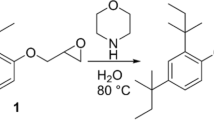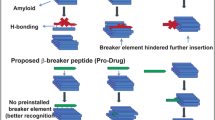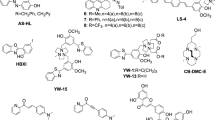Abstract
The production and accumulation of toxic amyloid plaques is one of the hallmarks of Alzheimer’s disease (AD). Amyloid beta (Aβ) peptides undergo self-aggregation to form soluble oligomers, protofibrils and insoluble fibrils. This process is termed as amyloidogenesis and is a major contributor to the observed neuronal damage and memory impairment in the AD brain. Therefore, modulation of Aβ aggregation process is considered to be an effective target to prevent neuronal damage under AD conditions. Modulation of amyloidogenesis involves inhibition of aggregation to form a toxic species or acceleration to drive the aggregation process to form species that are nontoxic by employing well-designed external ligands. In this context, we report a set of 2,3-dihydrophthalazine-1,4-dione (dihydrophthalazinedione, Phz) based small molecules (Phz 1–4) to modulate the Aβ42 aggregation and in cellular toxicity. Our detailed study (thioflavin T fluorescence assay, dot blot and transmission electron microscopy analysis) revealed fluorine containing Phz 4 as the potent modulator of Aβ42 aggregation by accelerating the process to form nontoxic aggregated species through hydrophobic and halogen interactions. Aβ42 aggregates formed in the presence of Phz 4 are mostly nontoxic when compared to the normal amyloid aggregates in the cellular milieu (PC12 cells). This study established that the hydrophobic and halogen interactions can be employed to develop anti-AD drug candidates. The excellent cell viability, effective modulation of Aβ42 aggregation to form nontoxic species and cellular (neuronal) rescue by Phz 4 offer a novel platform to develop therapeutic strategies for AD.





Similar content being viewed by others
References
Rajasekhar K, Chakrabarti M and Govindaraju T 2015 Chem. Commun. 51 13434
Alzheimer A 2015 Alzheimer’s Dementia 11 332
Selkoe D J and Hardy J 2016 EMBO Mol. Med. 8 595
Knowles T P, Vendruscolo M and Dobson C M 2014 Nat. Rev. Mol. Cell Biol. 15 384
De Strooper B and Karran E 2016 Cell 164 603
Chiti F and Dobson C M 2017 Annu. Rev. Biochem. 86 27
Rajasekhar K, Suresh S, Manjithaya R and Govindaraju T 2015 Sci. Rep. 5 8139
Rajasekhar K and Govindaraju T 2018 RSC Adv. 8 23780
Soto C, Sigurdsson E M, Morelli L, Kumar R A, Castaño E M and Frangione B 1998 Nat. Med. 4 822
Walsh D M and Selkoe D J 2007 J. Neurochem. 101 1172
Stefani M and Dobson C M 2003 J. Mol. Med. 81 678
Chimon S, Shaibat M A, Jones C R, Calero D C, Aizezi B and Ishii Y 2007 Nat. Struct. Mol. 14 1157
Mastrangelo I A, Ahmed M, Sato T, Liu W, Wang C, Hough P et al 2006 J. Mol. Biol. 358 106
Ahmed M, Davis J, Aucoin D, Sato T, Ahuja S, Aimoto S et al 2010 Nat. Struct. Mol. 17 561
Bieschke J, Herbst M, Wiglenda T, Friedrich R P, Boeddrich A, Schiele F et al 2012 Nat. Chem. Biol. 8 93
Rajasekhar K, Madhu C and Govindaraju T 2016 ACS Chem. Neurosci. 7 1300
Ramesh M, Makam P, Voshavar C, Khare H, Rajasekhar K, Ramakumar S et al 2018 Org. Biomol. Chem. 16 7682
Samanta S, Rajasekhar K, Babagond V and Govindaraju T 2019 ACS Chem. Neurosci. 10 3611
Rajasekhar K, Mehta K and Govindaraju T 2018 ACS Chem. Neurosci. 9 1432
Herbst M and Wanker E E 2006 Curr. Pharm. 12 2543
Habchi J, Arosio P, Perni M, Costa A R, Yagi-Utsumi M, Joshi P et al 2016 Sci. Adv. 2 e1501244
Habchi J, Chia S, Limbocker R, Mannini B, Ahn M, Perni M et al 2017 Proc. Natl. Acad. Sci. 114 E200
Bieschke J, Russ J, Friedrich R P, Ehrnhoefer D E, Wobst H, Neugebauer K et al 2010 Proc. Natl. Acad. Sci. 107 7710
Ladiwala A R A, Dordick J S and Tessier P M 2011 J. Biol. Chem. 286 3209
Ehrnhoefer D E, Bieschke J, Boeddrich A, Herbst M, Masino L, Lurz R et al 2008 Nat. Struct. Mol. Biol. 15 558
Cummings J L, Morstorf T and Zhong K 2014 Alzheimer’s Res. Ther. 6 37
Yang D S, Yip C M, Huang T J, Chakrabartty A and Fraser P E 1999 J. Biol. Chem. 274 32970
Limbocker R, Chia S, Ruggeri F S, Perni M, Cascella R, Heller G T et al 2019 Nat. Commun. 10 225
Shoup T, Normandin M, Takahashi K, Griciuc A, Dhaynaut M, Quinti L et al 2019 J. Nucl. Med. 60 114
Cheng Y, Ono M, Kimura H, Kagawa S, Nishii R, Kawashima H et al 2010 ACS Med. Chem. Lett. 1 321
Ono M, Kawashima H, Nonaka A, Kawai T, Haratake M, Mori H et al 2006 J. Med. Chem. 49 2725
Ono M, Cheng Y, Kimura H, Cui M, Kagawa S, Nishii R et al 2011 J. Med. Chem. 54 2971
Loureiro J A, Crespo R, Börner H, Martins P M, Rocha F A, Coelho M et al 2014 J. Mater. Chem. B 2 2259
Rajasekhar K, Narayanaswamy N, Murugan N A, Viccaro K, Lee H G, Shah K et al 2017 Biosens. Bioelectron. 98 54
Rajasekhar K, Narayanaswamy N, Murugan N A, Kuang G, Ågren H and Govindaraju T 2016 Sci. Rep. 6 23668
Giacomelli C E and Norde W 2005 Macromol. Biosci. 5 401
Rocha S, Thünemann A F, do Carmo Pereira M, Coelho M, Möhwald H and Brezesinski G 2008 Biophys. Chem. 137 35
Kim W and Hecht M H 2006 Proc. Natl. Acad. Sci. 103 15824
Jalili-Baleh L, Nadri H, Moradi A, Bukhari S N A, Shakibaie M, Jafari M et al 2017 Eur. J. Med. Chem. 139 280
Levine I I I H 1993 Protein Sci. 2 404
Hellstrand E, Boland B, Walsh D M and Linse S 2009 ACS Chem. Neurosci. 1 13
Petkova A T, Ishii Y, Balbach J J, Antzutkin O N, Leapman R D, Delaglio F et al 2002 Proc. Natl. Acad. Sci. 99 16742
Pike C J, Walencewicz-Wasserman A J, Kosmoski J, Cribbs D H, Glabe C G and Cotman C W 1995 J. Neurochem. 64 253
Shughrue P, Acton P, Breese R, Zhao W Q, Chen-Dodson E, Hepler R et al 2010 Neurobiol. Aging 31 189
Acknowledgements
We thank Prof C N R Rao, FRS, for constant support and encouragement, JNCASR, SwarnaJayanti Fellowship, the Department of Science and Technology (DST), Government of India (Grant DST/SJF/CSA-02/2015–2016), Sheikh Saqr Laboratory (SSL), ICMS-JNCASR. DG thank the JNCASR and SS thank CSIR, New Delhi for the research fellowships.
Author information
Authors and Affiliations
Corresponding author
Additional information
This article is part of the Topical Collection: SAMat Focus Issue.
Electronic supplementary material
Below is the link to the electronic supplementary material.
Rights and permissions
About this article
Cite this article
GHOSH, D., SAMANTA, S. & GOVINDARAJU, T. Dihydrophthalazinediones accelerate amyloid β peptide aggregation to nontoxic species. Bull Mater Sci 43, 309 (2020). https://doi.org/10.1007/s12034-020-02223-2
Received:
Accepted:
Published:
DOI: https://doi.org/10.1007/s12034-020-02223-2




